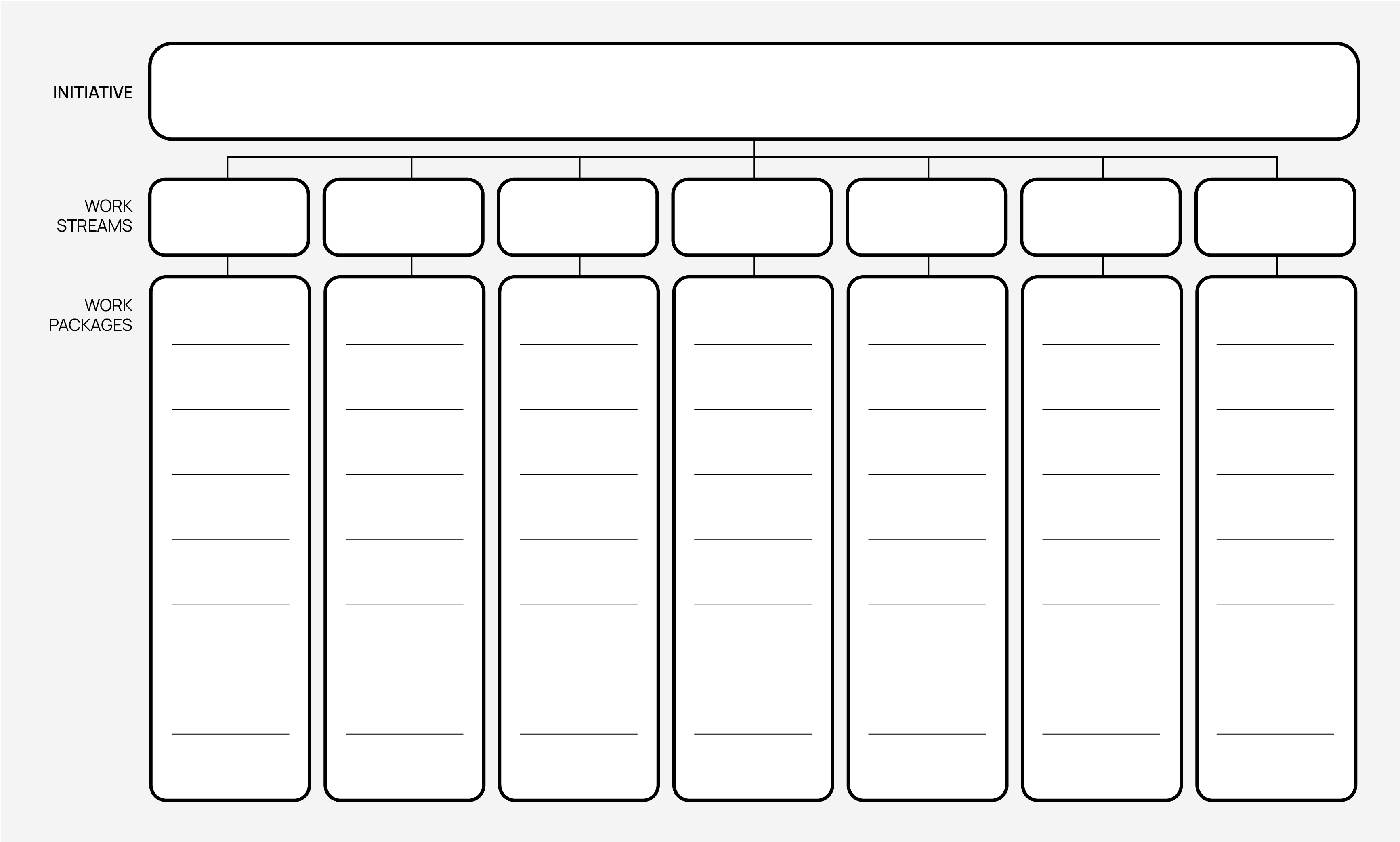Work breakdown structure
The Work Breakdown Structure (WBS) is a tool that breaks down a project or initiative into smaller parts, and can be used as a foundation for creating project plans, budgets and schedules.
The WBS is presented as a hierarchical tree structure, starting with the main goal at the top and breaking down into smaller, more detailed activities as you move down the levels.
Key concepts important for using a WBS:
Level 1 (Project or initiative definition): This is the highest level of the WBS hierarchy. It is where the project or initiative is clearly defined.
Level 2 (Workstreams): At this level, you identify the major deliverables or phases that need to be accomplished to complete the project or initiative.
Level 3 (Work packages): This level breaks down each major deliverable or phase identified at Level 2 into smaller, more detailed activities.
Level 4, 5, etc. (Sub-work packages): Depending on the complexity and granularity required for the project, you can continue to break down the WBS into additional levels.
The results
- A detailed set of actions which can be used to create a project schedule
- Improved clarity activities and responsibilities

When to use it
Project Planning: To effectively plan projects from start to finish.
Resourcing: To clarify roles and responsibilities for each item within a project.
Scheduling: To estimate and schedule the time required for each task delivery.
Strengths
Provides structure and clarity
Simple but effective
Weaknesses
Can be hard to maintain as projects evolve
Can be time-consuming
Not suitable for projects with high uncertainty / variable scope
How to use it?
What do I need to start?
A clear scope. This should include objectives, deliverables, and what is in and out of scope
How to use it?
Who to involve?
Work Breakdown Structure is best done with the people involved in delivering the work
Step by step
1
Review project scope and objectives
Clearly outline known information about the project – including objectives, deliverables, and scope boundaries.
2
Define the WBS approach
There are two common approaches to drafting a WBS: deliverables-based or phase-based.
Deliverable-based WBS: Work is broken down by the deliverables that need to be produced.
In a construction project, this might be foundations, structure, roofing, and interior finishes. Example:
Work-stream 1: Foundation
-
- Work package 1.1: Site excavation
- Work package 1.2: Concrete pouring
Work-stream 2: Structure
-
- Work package 2.1: Steel framing
- Work package 2.2: Concrete framing
- And so on
Phase-based WBS: Work is broken down by each phase of the project or initiative
In a construction project, this might be phases such as: initiation, planning, design, procurement, delivery, and closeout. Example:
Work-stream 1: Initiation
-
- Work package 1.1: Project charter
- Work package 1.2: Stakeholder identification
Work-stream 2: Planning
-
- Work package 2.1: Project management plan
- Work package 2.2: Schedule development
- And so on
3
Identify major deliverables or phases (Level 2)
Break down the project into major deliverables or phases
4
Define detailed tasks and deliverables (Level 3+)
Use a hierarchical structure to break down each deliverable or phase into smaller more manageable items. Ask questions like:
- Would further breaking this down improve execution?
Continue breaking down until the answer is no.
5
Identify responsibilities
Clearly define responsibilities for each package of the WBS.
Consider using a RASCI matrix for more comprehensive identification of roles.
6
Estimate effort (optional)
Ask the responsible person to estimate the effort of each package. Effort estimates can be used to develop a schedule.
7
Assign WBS Codes
Assign unique identifiers (codes) to each component of the WBS for easy reference and organisation. Codes typically follow a hierarchical numbering system (e.g. 1.1, 1.2, 1.2.1, etc.).
8
Validate and review
Review the WBS with stakeholders. Validate that all project deliverables and tasks are included in the WBS. Adjust the WBS as needed.
9
Document and publish the WBS
Document the finalised WBS in a clear and structured format. It can be useful to create a supplementary table, which can include key information such as descriptions, responsibilities and effort estimates for each package.